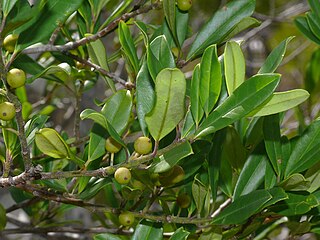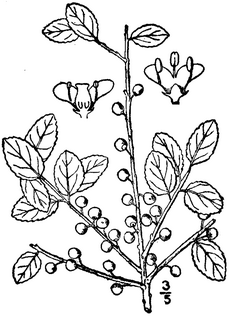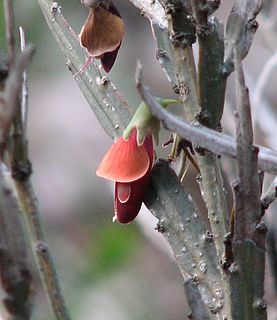
Quercus ilex, the evergreen oak, holly oak or holm oak, is a large evergreen oak native to the Mediterranean region. It takes its name from holm, an ancient name for holly. It is a member of the Cerris section of the genus, with acorns that mature in a single summer. Quercus rotundifolia was previously thought to be part of this species, but was later moved to its own.

Ilex opaca, the American holly, is a species of holly, native to the eastern and south-central United States, from coastal Massachusetts south to central Florida, and west to southeastern Missouri and eastern Texas.

Ilex cassine is a holly native to the southeastern coast of North America, in the United States from Virginia to southeast Texas, in Mexico in Veracruz, and in the Caribbean on the Bahamas, Cuba, and Puerto Rico. It is commonly known as dahoon holly or cassena, the latter derived from the Timucua name for I. vomitoria.

Ilex vomitoria, commonly known as yaupon or yaupon holly, is a species of holly that is native to southeastern North America. The word yaupon was derived from the Catawban yą́pą, from yą- tree + pą leaf. Another common name, cassina, was borrowed from Timucua. The Latin name comes from an incorrect belief by Europeans that the plant caused vomiting in certain ceremonies.

Ilex verticillata, the winterberry, is a species of holly native to eastern North America in the United States and southeast Canada, from Newfoundland west to Ontario and Minnesota, and south to Alabama.

Parasaurolophus is a genus of herbivorous hadrosaurid ornithopod dinosaur that lived in what is now North America and possibly Asia during the Late Cretaceous Period, about 76.5–73 million years ago. It was a herbivore that walked both as a biped and as a quadruped. Three species are universally recognized: P. walkeri, P. tubicen, and the short-crested P. cyrtocristatus. Additionally, a fourth species, P. jiayinensis, has been proposed, although it is more commonly placed in the separate genus Charonosaurus. Remains are known from Alberta (Canada), New Mexico and Utah, and possibly Heilongjiang (China). The genus was first described in 1922 by William Parks from a skull and partial skeleton found in Alberta.

Ilex aquifolium, the holly, common holly, English holly, European holly, or occasionally Christmas holly, is a species of flowering plant in the family Aquifoliaceae, native to western and southern Europe, northwest Africa, and southwest Asia. It is regarded as the type species of the genus Ilex, which by association is also called "holly". It is an evergreen tree or shrub found, for example, in shady areas of forests of oak and in beech hedges. In the British Isles it is one of very few native evergreen trees. It has a great capacity to adapt to different conditions and is a pioneer species that repopulates the margins of forests or clearcuts.
The Nymphomyiidae are a family of tiny (2 mm) slender, delicate flies (Diptera). Larvae are found among aquatic mosses in small, rapid streams in northern regions of the world, including northeastern North America, Japan, the Himalayas, and eastern Russia. Around a dozen extant species are known, with two fossil species found in amber, extending back to the Mid Cretaceous. Under an alternative classification, they are considered the only living representatives of a separate, suborder called Archidiptera which includes several Triassic fossil members. The family has characteristics associated with the Nematocera as well as the Brachycera. The antennae are shortened as in the Brachycera and these flies are long, having a snout with vestigeal mouthparts, non-differentiated abdominal segments with large cerci. The wings are narrow and hair-fringed and have very weak venation. They are known to form cloud-like swarms in summer and the short-lived non-feeding adults have wings that fracture at the base shortly after mating.

Ilex guayusa is a species of tree of the holly genus, native to the Amazon Rainforest. One of four known caffeinated holly trees, the leaves of the guayusa tree are harvested fresh and brewed like a tea for their stimulative effects.

Kuding or kuzding is a particularly bitter-tasting Chinese infusion, which due to their similarities in appearance is derived from several plant species. The two most common plants used to make kuding are the wax tree species Ligustrum robustum and the holly species Ilex kaushue, the former being more commonly grown in Sichuan and Japan while the latter is most commonly grown and used in the rest of China. Tea produced from Ligustrum or Ilex is caffeine-free.

Ilex glabra, also known as Appalachian tea, dye-leaves, evergreen winterberry, gallberry, and inkberry, is a species of evergreen holly native to the coastal plain of eastern North America, from coastal Nova Scotia to Florida and west to Louisiana where it is most commonly found in sandy woods and peripheries of swamps and bogs. Ilex glabra is often found in landscapes of the middle and lower East Coast of the United States. It typically matures to 5–8 ft (1.5–2.4 m) tall, and can spread by root suckers to form colonies. It normally is cultivated as an evergreen shrub in USDA zones 6 to 10.

Pluridens is an extinct genus of marine lizard belonging to the Mosasauridae. Pluridens is placed in the subfamily Halisaurinae with the genera Phosphorosaurus, Eonatator and Halisaurus. Compared to related halisaurines, Pluridens had longer jaws with more teeth, and smaller eyes. It also grew large size, perhaps 8 or 9 meters in some individuals. The jaws in some specimens are robust, and sometimes show injuries suggestive of combat. The jaws may have been used for fighting over mates or territories.

The pygmy long-eared bat is a vespertilionid bat, found in the north of the Australian continent. An insectivorous flying hunter, they are one of the tiniest mammals in Australia, weighing only a few grams and one or two inches long.

Liolaemus walkeri is a species of lizard in the family Liolaemidae. The species is endemic to South America.
Explorornis is a genus of Mesozoic birds which lived during the mid-late Turonian stage, around 90 million years ago, in the Bissekty Formation of the Kyzyl Kum, in present-day Uzbekistan.

Bossiaea walkeri, commonly known as cactus bossiaea, cactus pea, or Walker's stick bush is a species of flowering plant in the pea family (Fabaceae) and is endemic to southern mainland Australia. It is a rigid, much-branched shrub with flattened, winged cladodes and red, pea-like flowers between July and November in the species' native range.

Ilex, or holly, is a genus of over 560 species of flowering plants in the family Aquifoliaceae, and the only living genus in that family. Ilex has the most species of any woody dioecious angiosperm genus. The species are evergreen or deciduous trees, shrubs, and climbers from tropics to temperate zones worldwide. The type species is Ilex aquifolium, the common European holly used in Christmas decorations and cards.

Contradusta walkeri is a species of sea snail, a cowry, a marine gastropod mollusk in the family Cypraeidae, the cowries.

Scheenstia is an extinct genus of neopterygian ray-finned fish from the Late Jurassic–Early Cretaceous periods. Fossils have been found in Bavaria, France, and England.

Aeshna walkeri, or Walker's darner, is a species of darner in the dragonfly family Aeshnidae. It is found in Central America and North America.

















